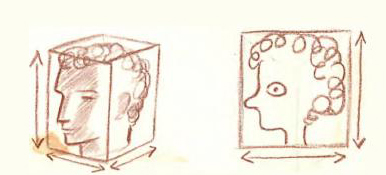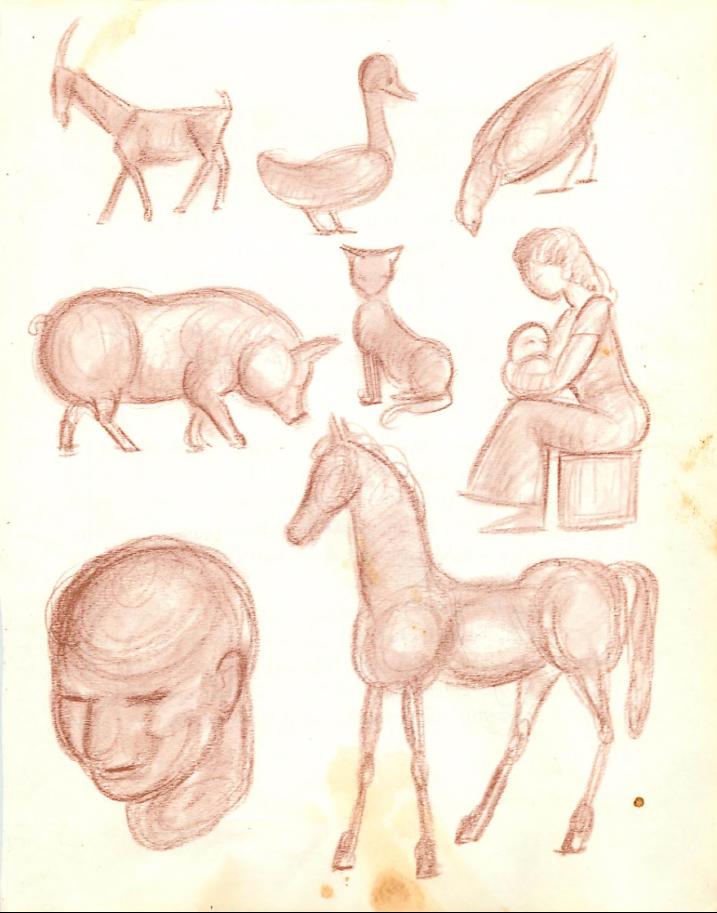
|

THE SHAPES OF THINGS
Just about anything you see has its own special shape. And that
special shape is made up of smaller shapes. They are the most important
reason why things look the way they do. When you make a drawing
of something, you are really drawing its main shape and the smaller
shapes that are part of it. Therefore, the first thing you need to learn
is to see and know these shapes.
DRAWING THE SHAPES
Have you ever noticed that the drawings of most beginners look
flat and unreal? That is because the young artists have drawn only the
outlines of shapes. They have given them only two dimensions, or
measurements -- the height and the width. What is lacking is the
depth, or thickness, of the shape. We call it the third dimension, and
good artists always try to draw it along with the other two dimensions.
There are many ways of drawing the three dimensions of a shape.
Here is one that has been used by many great artists for thousands of
years. First look carefully at the object you want to draw. Try to see
the large shapes that make up that object. When you think you know
what they are, take a broad pencil, a crayon, or a piece of charcoal,
and go to work.
STUDYING SHAPES

On the picture above, there are a number of shapes of different
things.
Take a colored pencil and try to copy them. But don't try too
hard! Be brave!
Be free! Scribble or smudge away until you have
the shape you want. Forget
about neatness.
Remember that you are practicing drawing now, not making
something to hang on the wall. Use cheap but strong paper that will
not tear or
crumble as you work. Ordinary wrapping paper is as good
as any. Draw quickly,
and don't worry about the lines you draw.
Scribble or smudge the shapes down
any old way, so long as you get
them down. Try using the side of your crayon,
or the broad side of
your pencil or charcoal. Use your thumb or your fingers to
smudge the
shapes onto the paper. And keep thinking about the thickness of the
shapes you are drawing.
You can work on large or small sheets of paper. Keep
a pad in
your pocket and when you see something that interests you, study its
shapes and try to scribble them down on your pad. Do it again and
again until
you have something that satisfies you. Master the shapes
before you try to put in
any details at all. Artists, even great artists,
are always studying the shapes of things
around them, scribbling and
smudging them down on paper, just for practice.
Now, when your shape is as good as you can make it, take a
pencil of a different color and surround the shape you have made with
a firm line. I used a black line to outline the reddish shapes I scribbled.
This method of using one color for studying shapes and a deeper
color for doing the final drawing has been in use for thousands of years.
There are still other ways of drawing an object after you have
studied it and put its shape on paper. One way is to cover the shape
you have scribbled with a sheet of tracing or lightweight typewriter
paper and trace it again and again until you are satisfied. Then put
down some final lines to surround it and make it definite.

MORE ABOUT DRAWING SHAPES
There is a great deal more to learn about shapes than can be
learned by looking at their outside surfaces. What makes a shape look
full, strong, weak, thin, soft, or hard? It is not what you see on the
outside, but the inner structure -- the skeleton and muscles of the shape.
nearly all things have them.
Four or five hundred years ago, such great artists as Leonardo da
Vinci and Michelangelo studied the anatomy, or structure, of human
beings and animals so thoroughly that they knew more about bones
and muscles than did the doctors of those days. Their anatomical
drawings are so true that they are used by students of anatomy even today.

Anatomical drawings by Leonardo do Vinci (1452-1519)
There were and are -- artists who studied the geometric shapes
of the subjects they tried to draw. Geometric shapes are cubes, spheres,
and things like that. These artists tried to see the shapes without any
surface detail at all. Then they built the human figure, or the animal,
or whatever it was they were drawing, with cubes, spheres, and other
geometric shapes. I believe that a combination of these two methods -- the study of
the anatomy of an object and the study of geometric shape -- is the
best way to develop a sense of the shape of things so that you can make
good drawings.
|








